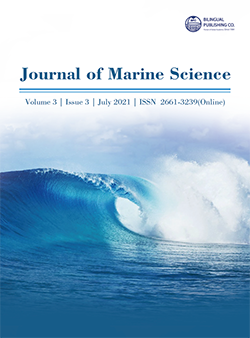Dragonflies as an Important Aquatic Predator Insect and Their Potential for Control of Vectors of Different Diseases
DOI:
https://doi.org/10.30564/jms.v3i3.3121Abstract
Mosquitoes belong to order of Diptera. The main important vectors are genus Aedes, Culex and Anopheles. They transmit different agents such bacteria, viruses, and parasites. According to the latest information around 7 hundred million people around the world are suffering from mosquitoborne illness resulting over one million deaths. The main important disease transmitted by Anopheles is malaria. Other genus of mosquitoes including Aedes and Culex species transmit different arboviral disease to human. According to guideline of World Health Organization, the mina control of disease is vectors control. The main important vector control is using different insecticides. Using chemical insecticides for controlling mosquitoes is limited because they develop resistance against these insecticides. So, efforts have been made to control the mosquito vectors by eco-friendly techniques. In this research all, the relevant information regarding the topic of research is research through the internet and used in this paper. An intensive search of scientific literature was done in “PubMed”, “Web of Knowledge”, “Scopus”, “Google Scholar”, “SID”, etc Results shows that one of important environmental friendly vector control is biological control, using different predators and other microorganisms for vector and pest control. Dragonflies do eat mosquitos and serve as mosquito predators. They feed on mosquitos and reduce their number in outdoor areas. The dragonflies are scary biters, but they are dangerous to mosquitos. Worldwide results showed that dragonflies are able to control Aedes, Culex and Anopheles mosquito species. The artificial rearing of these predators and releasing for biological control is an appropriate measure for vector control worldwide.
Keywords:
Mosquito; Diseases; Predator; DragonflyReferences
[1] Jacob, S. Thomas A. Manju, E. (2017), “ Bio-control efficiency of Odonata nymphs on Aedes aegypti larvae” .IOSR J. Environ. Sci.,11, 1-4.
[2] Mandal, S. Ghosh, A. Bhattacharjee, I. Chandra, G. (2008), “ Bio-control efficiency of odonate nymphs against larvae of the mosquito,Culex quinquefasciatus Say, 1823”. Acta. Trop., 106, 109-114.
[3] Shaalan, EA. Canyon, DV. (2009),” Aquatic insect predators and mosquito control”. Trop. Biomed.,26, 223-261.
[4] Saha, N. Aditya, G. Banerjee, S. Saha, GK. (2012) “ Predation potential of odonates on mosquito larvae: Implications for biological control” . Biol. Control., 63, 1-8.
[5] Morales, ME. Wesson, DM. Sutherland, IW. Impoinvil DE. Mbogo, CM. Githure, JI. Beier, JC. (2003), “ Determination of Anopheles gambiae larval DNA in the gut of insectivorous dragonfly (Libellulidae) nymphs by polymerase chain reaction” . J. Am. Mosq.Control Assoc.,19, 163-165.
[6] Mary, R. (2013), “Ecology and predatory efficiency of aquatic (odonate) insect over the developmental stages of mosquitoes (Diptera:Culicidae)” .J. Acad. Ind. Res.,2, 429.
[7] Norma-Rashid, Y. Saleeza, S. (2014), “Eco-friendly control of three common mosquito larvae species by odonata nymphs. in basic and applied aspects of biopesticides” , 2nd ed.; Sahayaraj, K., Ed.; Springer: New Delhi, India, pp. 235-243.
[8] Akram, W. Ali-Khan, HA. (2016),” Odonate nymphs: Generalist predators and their potential in the management of dengue mosquito,Aedes aegypti (Diptera: Culicidae)” .J. Arthropod. Borne Dis.,10, 252-260.
[9] Vershini, R. Kanagapan, M. (2014), “ Effect of quantity of water on the feeding efficiency of dragonfly nymph-Bradynopyga geminate (Rambur): .J. Entomol. Zool. Stud.,2, 249-252.
[10] Singh, RK. Dhiman, RC. Singh, SP. (2003),” Laboratory Studies on the predatory potential of dragon-fly nymphs on mosquito larvae” . J. Commun. Dis., 35, 96-101.
[11] Quiroz-Martínez, H. Rodríguez-Castro, A. (2007),” Aquatic insects as predators of mosquito larvae: . J. Am. Mosq. Control Assoc., 23, 110-117.
[12] Acquah-Lamptey, D. Brandl, R. (2018),” Effect of a dragonfly (Bradinopyga strachani Kirby, 1900) on the density of mosquito larvae in a field experiment using mesocosms”. Web . Ecol. 18, 81-89.
[13] El Rayah, EA. (1975),” Dragonfly nymphs as active predators of mosquito larvae”. Mosq. News., 35, 229- 230.
[14] Hedlund J, Ehrnsten E, Hayward C, Lehmann P, Hayward A. (2020),” New records of the Paleotropical migrant Hemianax ephippiger in the Caribbean and a review of its status in the Neotropics”. Inter. J. Odonatology, 23:4,315-325.
[15] Sebastian A, Thu MM, Kyaw M, Sein MM. (1980) ,” The use of dragonfly nymphs in the control of Aedes aegypti”. Southeast Asian. J. Trop. Med. Public Health., 11(1):104-7.
[16] Sebastian, A. Sein, MM. Thu, MM. Corbet, PS (1990),” Suppression of Aedes aegypti (Diptera: Culicidae) using augmentative release of dragonfly larvae (Odonata: Libellulidae) with community participation in Yangon, Myanmar”. Bull. Entomol. Res. 80, 223-232.
[17] Chatterjee, SN. Ghosh, A. Chandra, G. (2007),” Eco-friendly control of mosquito larvae by Brachytron pratense nymph”. J. Environment. Health., 69(8), 44-49.
Downloads
Issue
Article Type
License
Copyright and Licensing
The authors shall retain the copyright of their work but allow the Publisher to publish, copy, distribute, and convey the work.
Journal of Marine Science publishes accepted manuscripts under Creative Commons Attribution-NonCommercial 4.0 International License (CC BY-NC 4.0). Authors who submit their papers for publication by Journal of Marine Science agree to have the CC BY-NC 4.0 license applied to their work, and that anyone is allowed to reuse the article or part of it free of charge for non-commercial use. As long as you follow the license terms and original source is properly cited, anyone may copy, redistribute the material in any medium or format, remix, transform, and build upon the material.
License Policy for Reuse of Third-Party Materials
If a manuscript submitted to the journal contains the materials which are held in copyright by a third-party, authors are responsible for obtaining permissions from the copyright holder to reuse or republish any previously published figures, illustrations, charts, tables, photographs, and text excerpts, etc. When submitting a manuscript, official written proof of permission must be provided and clearly stated in the cover letter.
The editorial office of the journal has the right to reject/retract articles that reuse third-party materials without permission.
Journal Policies on Data Sharing
We encourage authors to share articles published in our journal to other data platforms, but only if it is noted that it has been published in this journal.




 Hassan Vatandoost
Hassan Vatandoost

